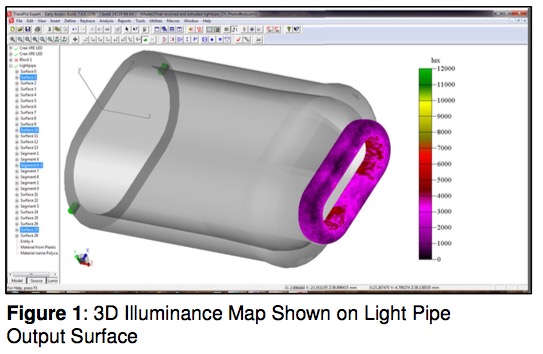How to Design Efficient Light Pipes – TracePro Optimization
Design Intricate Light Pipes Optimized for Utility, Efficiency, Color, and Uniformity
Light pipes, also known as light guides, are integral components in various industries, including automotive, avionics, and consumer electronics. Their primary function is to channel light efficiently, ensuring an even distribution of light across instrument panels and other critical applications. For engineers integrating these light pipes, maintaining standards of uniformity, color fidelity, and overall efficiency is crucial to ensuring product performance. As the demand for high-quality, consistent lighting grows, so does the complexity involved in optimizing light pipe designs to meet these standards.
Achieving the ideal balance between uniformity, color, efficiency, and appearance is no small feat. The design process encompasses numerous variables that must be meticulously controlled. Unlike the relatively straightforward design of basic luminaires, light pipes present unique challenges due to their reliance on multiple light sources, intricate geometries, and material properties that significantly influence their performance. From selecting the right materials to managing surface properties and geometric shapes, the intricacies of light pipe design extend well beyond simple lighting solutions.
At the core of effective light pipe design lies the clever manipulation of various optical principles such as Snell’s Law, Fresnel Loss, and Total Internal Reflection (TIR). These principles help to direct light from the source to one or more target points while maintaining maximum efficiency. The choice of materials and surface finishes also plays a vital role, contributing to the final color and uniformity of the light output. Whether working with LEDs or traditional lamps, the designer must consider every factor, including the physical characteristics of the light source, to create an optimal design.
TracePro, a comprehensive optical design software, provides designers with the tools necessary to navigate these complexities. Through its robust set of features, including CAD sketch utilities, optimization tools, and visualization options, TracePro enables engineers to design, analyze, and optimize light pipes with precision. Starting with a basic conceptual design, the software allows for the digitization of variable limits and the establishment of key parameters like illuminance, luminous intensity, and color uniformity.

One of the standout features of TracePro is its light pipe optimization capability. Designers can define merit functions with weighted operands to balance the relative importance of different optimization goals, such as efficiency, color accuracy, and angular distribution. This powerful optimization tool, paired with TracePro’s macro language, enables the iteration of geometry, positional adjustments, and even temperature variations during the design process. The result is a highly adaptable design workflow that can accommodate a wide range of lighting scenarios and performance requirements.
Every step of the design process, from concept to final output, is fully trackable in TracePro. Efficiency, illuminance, color, and uniformity are all monitored, providing real-time feedback to guide design decisions. Whether the project involves the use of advanced LED systems or more traditional lighting technologies, TracePro's extensive feature set ensures that engineers have the resources they need to achieve stunning results.
Features
- Extensive Property Catalogs: Includes materials, surfaces, textures, and light sources, with customizable options.
- Advanced Utilities: Tools like the Surface Source Property Generator and IES/LDT Analysis aid in the design and analysis process.
- Photorealistic Visualization: Enables users to visualize light output in real-time for better design insight.
- Interactive Optimizers: Includes specialized tools like the Texture Optimizer for refining light pipe performance.
- In-Depth Analysis Tools: Offers illuminance mapping, 3D geometry analysis, candela plots, flux reporting, and ray tracing capabilities for comprehensive light performance evaluations.
With TracePro, engineers are empowered to create innovative, efficient, and aesthetically pleasing light pipe designs, ensuring that their products meet the high standards required in today's competitive marketplace.




